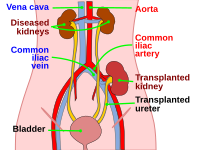
Photo from wikipedia
BACKGROUND Robot-assisted kidney transplantation (RAKT) has recently been introduced to reduce the morbidity of open kidney transplantation (KT). OBJECTIVE To evaluate perioperative and early postoperative RAKT outcomes. DESIGN, SETTING AND… Click to show full abstract
BACKGROUND Robot-assisted kidney transplantation (RAKT) has recently been introduced to reduce the morbidity of open kidney transplantation (KT). OBJECTIVE To evaluate perioperative and early postoperative RAKT outcomes. DESIGN, SETTING AND PARTICIPANTS This was a multicenter prospective observational study of 120 patients who underwent RAKT, predominantly with a living donor kidney, in eight European institutions between July 2015 and May 2017, with minimum follow-up of 1 mo. The robot-assisted surgical steps were transperitoneal dissection of the external iliac vessels, venous/arterial anastomosis, graft retroperitonealization, and ureterovesical anastomosis. OUTCOME MEASUREMENTS AND STATISTICAL ANALYSIS Descriptive analysis of surgical data and their correlations with functional outcomes. RESULTS AND LIMITATIONS The median operative and vascular suture time was 250 and 38min, respectively. The median estimated blood loss was 150ml. No major intraoperative complications occurred, although two patients needed open conversion. The median postoperative estimated glomerular filtration rate was 21.2, 45.0, 52.6, and 58.0ml/min on postoperative day 1, 3, 7, and 30, respectively. Both early and late graft function were not related to overall operating time or rewarming time. Five cases of delayed graft function (4.2%) were reported. One case (0.8%) of wound infection, three cases (2.5%) of ileus, and four cases of bleeding (3.3%; three of which required blood transfusion), managed conservatively, were observed. One case (0.8%) of deep venous thrombosis, one case (0.8%) of lymphocele, and three cases (2.5%) of transplantectomy due to massive arterial thrombosis were recorded. In five cases (4.2%), surgical exploration was performed for intraperitoneal hematoma. Limitations of the study include selection bias, the lack of an open control group, and failure to report on patient cosmetic satisfaction. CONCLUSIONS When performed by surgeons with robotic and KT experience, RAKT is safe and reproducible in selected cases and yields excellent graft function. PATIENT SUMMARY We present the largest reported series on robot-assisted kidney transplantation. Use of a robotic technique can yield low complication rates, rapid recovery, and excellent graft function. Further investigations need to confirm our promising data.
Journal Title: European urology
Year Published: 2018
Link to full text (if available)
Share on Social Media: Sign Up to like & get
recommendations!